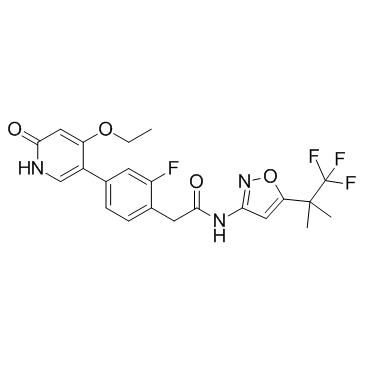| Description |
RET Kinase inhibitor 1 is a RET kinase inhibitor extracted from patent WO2014141187A1, compound example 27, has an IC50 of < 100 nM.
|
| Related Catalog |
|
| Target |
IC50: < 100 nM (RET kinase)[1]
|
| In Vitro |
The patent WO2016038519A1 describes a series of compounds which are indicated as inhibitors of the Rearranged during Transfection (RET) kinase, and which are indicated as being useful in the treatment of RET-mediated disorders. Specifically disclosed in that application is the compound RET Kinase inhibitor 1 (Compound A)[2].
|
| Kinase Assay |
Human RET kinase cytoplasmic domain is expressed as an N-terminal GST-fusion protein using a baculovirus expression system. GST-RET is purified using glutathione sepharose chromatography. The RET kinase enzymatic assay is performed in a total volume of 10 uL with increasing concentrations of RET kinase inhibitor as a singlet in a 384 well format as follows: RET inhibitor compound plates are prepared by adding 100 nL of RET inhibitor at different concentrations to a 384-well plate. 5 μE/well of a 2X enzyme mix (50 mM HEPES; 1 mM CHAPS; 0.1 mg/mL BSA; 1 mM DTT; 0.2 nM RET kinase) is added to the 384-well plate and incubated for 30 minutes at 23°C. 5 μE/well of a 2X substrate mix (50 mM HEPES; 1 mM CHAPS; 0.1 mg/mL BSA; 20 μM adenosine triphosphate; 20 mM MgCl2 and 1 μM biotinylated peptide substrate) is added and incubated for 1 hour at 23°C. 10 μE/well of 2X stop/detection mix (50 mM HEPES; 0.1 % BSA; 800 mM Potassium Fluoride; 50 mM EDTA; 200 X dilution of Europium Cryptate labeled anti- phosphotyrosine antibody; 62.5 nM Streptavidin-XL665) incubated for 1 hour at 23°C and read on a Homogenous Time-Resolved Fluorescence reader. IC50s are fitted using GraphPad Prism to a sigmoidal dose response[1].
|
| Cell Assay |
The potency of the compound of the invention is tested for its ability to inhibit cell proliferation and cell viability. TT cells (ATCC CRL-1803), a medullary thyroid cancer cell line with constitutively activated RET kinase, are maintained in 150 cm2 dishes in F12 Kaighn's medium, 10% fetal bovine serum, IX Glutamax, IX non-essential amino acids, IX Pen/Strep antibiotics at 37°C in 5 % carbon dioxide. 6.0E3 TT cells/well in 50 μL of media are added to a 96-well cell culture plate and allowed to adhere overnight. 50 μL of serially diluted RET inhibitor compounds are added to 96-well plate containing cultured TT cells and incubated at at 37°C in 5 % carbon dioxide for eight days. 50 of CellTiter-Glo is added, contents mixed for 1 minute on shaker followed by 10 minutes in the dark at 23 °C and the luminescence read by En Vision. IC50S are fitted using GraphPad Prism to a sigmoidal dose response[1].
|
| References |
[1]. Hilary Schenck Eidam, et al. Pyridine derivatives as rearranged during transfection (ret) kinase inhibitors. WO 2014141187 A1. [2]. Mui Cheung, et al. Crystalline forms of 2-(4-(4-ethoxy-6-oxo-1,6-dihydropyridin-3-yl)-2-fluorophenyl)-n-(5-(1,1,1-trifluoro-2-methylpropan-2-yl)isoxazol-3-yl)acetamide. WO 2016038519 A1.
|
